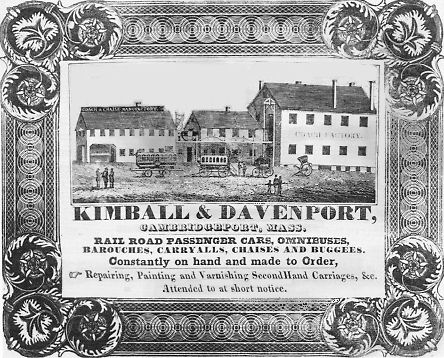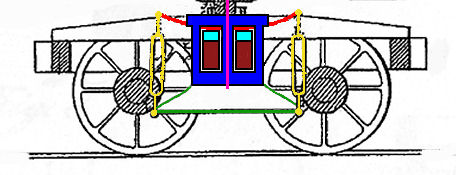Davenport & BridgesKimball & Davenport
|
 |
|
Advertisement from about 1835. |
As with so many car builders to follow, coach and carriage building soon lead to railway car building, but with Kimball & Davenport it was an even more natural progression, as in these early days of railway in the United States, railway cars were little more than road coaches mounted on flanged wheels. In some cases the wheels projected into the interior of the car. {488}
In 1834, Kimball & Davenport built some four-wheeled cars for the Boston & Worcester Railroad. Each car seated 24 passengers. One source says —
|
“For this order Mr. Davenport designed a car with the passageway running its entire length and permitting the passengers to all face the same way. This was the beginning of the American type of railroad passenger car. The first cars had the entrance door in the center of the body, with a step on both sides running along the entire length of the car, similar to the running board on the later-day open trolley car.” {439} |
Kimball & Davenport built similar cars for the Eastern Railroad too. They were so successful that more were ordered in 1837, and these had platforms and doors at each end as well as the passageway through the middle of the car. {489} These cars were also the first to have a ladies' room and toilet rooms. {488}
These cars also included the Davenport drawbar, for which Charles Davenport had received a patent 9 September 1835, and were equipped with reversible seats, which made it unnecessary to turn cars at the end of the line. {488} The drawbar eased the shock of starting a train by connecting the drawbar of each car to its frame by means of a full leaf spring, and the seats reversed in the manner we know as a "walk-over," flipping the back of the seat from one side to the other. {442}
In 1837, Davenport produced 8-wheeled cars seating 60 passengers, and 16-wheeled cars seating 76 passengers! {439}
Ebenezer Kimball died in 1839, and Davenport took on a new partner: Albert Bridges. And here the historical records begin to differ.
Leaders of Cambridge Industry, written in 1931, says Albert Bridges was a legacy left to Charles Davenport by Ebenezer Kimball as a means of assuring the future welfare of his daughter, Albert’s wife, and that Albert “knew nothing of the business, was neither mechanic nor business man, and [the authors] are told that his connection with the firm was always a nuisance to Mr. Davenport.” {439}
In evaluating this information, you must be aware of three things:
| o | the authors had previously mentioned being given information by Charles Davenport’s daughter-in-law, and her memories were likely a recollection of stories related by her father-in-law, and those stories may have been colored by conditions surrounding the break-up of the partnership at the end of 11 years, |
| o | Leaders of Cambridge Industry presents evidence that Ebenezer Kimball died August 14, 1839, and it is known Albert Bridges married Eliza Ann Kimball October 15, 1839. So the marriage apparently took place after Ebenezer Kimball’s death, not before. It would be interesting to know the exact date in 1839 that the partnership became effective, but it is unlikely such a thing was ever recorded, and finally, |
| o | Albert Bridges went on to start a railway supply business of his own that appears to have been quite successful; A. Bridges & Co. was still going strong in 1860. Perhaps Albert found another partner who could support him as Charles Davenport supposedly did? |
On the other hand, The History of Middlesex County, Massachusetts, written in 1890, suggests that Albert Bridges and his twin brother Alfred, had grown up with Charles Davenport and his brother Alvin from their childhood in Newton Upper Falls, Massachusetts, and that all four were mechanically inclined by nature. It even goes so far as to say that when Albert Bridges joined Charles Davenport in the business at Cambridgeport, Alfred Bridges joined Alvin Davenport in opening a related shop (Davenport & Bridges, what else?) at Fitchburg. {425}
In evaluating this information, we must remember that this volume is of the genre of “vanity biographies” that were in vogue from the time of the Civil War until shortly after the turn of the century, and that these volumes had two main characteristics:
| o | they were based almost entirely on the memories of the people whose lives and businesses were described, and who would be the prospects for sale of the books (that’s where the “vanity” comes in), and |
| o | they never had anything but good to say about anyone; after all, why alienate a potential buyer? |
A sample will illustrate both these points. “Mr. Bridges [senior] had two sons, twin brothers, who developed in childhood a strong mechanical turn of mind. These lads had for playmates the sons of Mr. Joseph Davenport, a near neighbor to them, - and as the Davenport boys were also mechanically inclined, it was very natural for them to spend their leisure hours in rudely constructing mechanical devices with jack-knives and hammers. In after-life these lads formed a co-partnership in business for building railway cars.” . . . You get the idea!
But interestingly, we have evidence that a firm styled Davenport, Bridges & Company did have a factory at Fitchburg in 1848/49 (see later write-up).
In any event, in 1839 the partnership of Davenport & Bridges succeeded the partnership of Kimball & Davenport. And in each case, as is typical, the first-named was the senior partner, and generally the one that put up the most money. Davenport & Bridges would become the leading manufacturer of railroad cars in the United States, and be recognized as such in railroad circles for the next 20 years. {439}
 |
|
(American Railway Times, 14 March 1850) |
The next year (1840) Davenport & Bridges produced the 1st four passenger cars for the New York & Erie railroad. These cars were of the 8-wheeled variety, with bodies 36'-0" long and 11'-0" wide. (Remember that the Erie railroad then had a 6'0" track gauge!) But these cars were only 6'-0" “in the clear” inside. Though people were not as tall then as now, it nevertheless must have been a low overhead. These cars had a capacity of 36 passengers, and cost $2,000 each. {Citation?}
Davenport & Bridges also contracted to build two platform cars 31'-0" long and the same width and height as the passenger cars to carry “baggage crates.” These “baggage crates” were roughly roughly 7' square by 5' high and were mounted on small wheels. Luggage of every variety was packed into these crates and the crates then loaded onto the platform cars, as many as five crates to a car. (And you thought containers were a modern invention!) The two cars cost $750 each, and the ten crates $75 each. {Same citation as above + White/Pass-455, citing E.H. Mott, Between the Ocean and the Lake; The Story of the Erie, (New York, NY: John S. Collins, 1901), p. 397.}
In 1841, Charles Davenport invented the lateral motion car truck. As his patent application said: “Most persons, who travel by railroad, experience a continual repetition of sudden jars or shocks, arising from the side way movement [sic] of the flanges of the wheels of the car, against the rails of the track and . . . it is highly injurious to the carriages causing the joints and other parts to become loose and soon deranged.” {443}
Davenport’s solution was a crude model of what would later be called a “lateral motion” car truck; he —
| o | placed a pair of cross-members, called transoms, between the truck side frames at the middle to connect them as the truck bolster had previously done [brown in the illustration below], |
| o | created a truck bolster that encased the transoms without restricting them and that was deeper than they [blue in the illustration], |
| o | suspended the bottom of the truck bolster from the transoms by a set of links and springs so it could move up, down and sideways [green, yellow and red in the illustration], and |
| o | added springs and dampers to dampen the sideways movement of the bolster and limit it to about 1" either way [don't show]. |
The effect of this was that the car body was no longer sitting rigidly on top of the truck, pushed suddenly sideways each time the truck moved suddenly sideways, but actually suspended flexibly from the truck so that it was swung sideways with something of a lag that dampened the jerkiness of the movement (in much the way that a highway coach swung on leather straps).
 |
|
Portion of Davenport’s patent drawings which we have doctored up a bit with color to make the action more visible. |